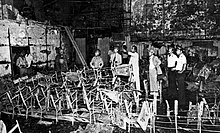| Cinema Rex fire | |
|---|---|
| Part of the Iranian Revolution | |
 Interior of the Cinema Rex building after the fire | |
| Native name | آتشسوزی سینما رکس آبادان |
| Location | Abadan, Iran |
| Date | 19 August 1978 20:21 (IRST) |
Attack type | Arson, mass murder, terrorism |
| Deaths | 377–470 killed[1] |
| Perpetrators | Islamic militants[2][1][3] |
No. of participants | 4 personnel |
The Cinema Rex fire (Persian: آتشسوزی سینما رکس آبادان, lit. 'Rex Abadan cinema fire') happened on 19 August 1978 when the Cinema Rex in Abadan, Iran was set ablaze, killing between 377[1] and 470 people.[4] The event started when four individuals, who were militants motivated by Islamic extremism,[2] doused the building with airplane fuel before setting it alight.[5] The attack was responsible in part for triggering the Iranian Revolution of 1979, which saw the overthrow of the ruling dynasty under the Iranian monarch and a related outbreak of mass violence. It was the deadliest terrorist attack in history until the 1990 massacre of Sri Lankan Police officers.
The governing dynasty initially blamed "Islamic Marxists" for the fire[6] and later reported that Islamic militants started the fire,[7][8][9][10] while anti-Pahlavi protesters falsely[2] blamed SAVAK, the Iranian secret police, for setting the fire.[11][12] Even though Islamic extremists were responsible for the attack, the Islamic opposition benefited greatly from the disaster in terms of propaganda because of the general atmosphere of mistrust and wrath. Many Iranians accepted the disinformation, which fueled growing anti-Shah fervor.
According to Roy Mottahedeh, an American historian who authored The Mantle of the Prophet, "thousands of Iranians who had felt neutral and had until now thought that the struggle was only between the shah and supporters of religiously conservative mullahs felt that the government might put their own lives on the block to save itself. Suddenly, for hundreds of thousands, the movement was their own business."[13]
- ^ a b c Amanat, Abbas (2017). Iran: A Modern History. Yale University Press. p. 719. ISBN 978-0300112542.
- ^ a b c Cite error: The named reference
Tuckerwas invoked but never defined (see the help page). - ^ Cite error: The named reference
Kashani-Sabetwas invoked but never defined (see the help page). - ^ "Iran: In with the madding crowd". The Economist. 3 November 2012. Retrieved 2 March 2014.
- ^ Cite error: The named reference
Amuzegar1991was invoked but never defined (see the help page). - ^ "BBC فارسی - ايران - گاهشمار انقلاب" (in Persian). Retrieved 1 January 2018.
- ^ Afkhami, R. Gholam (2009) The Life and Times of the Shah University of California Press, pages 465 & 459, ISBN 0-520-25328-0
- ^ Ansari, M. Ali (2007) Modern Iran: the Pahlavis and after Pearson Education, page 259, ISBN 1-4058-4084-6
- ^ Federal Research Division (2004) Iran A Country Study Kessinger Publishing, page 78, ISBN 1-4191-2670-9
- ^ Bahl, Taru, Syed, M. H. (2003) Encyclopaedia of the Muslim World, Anmol Publications PVT. LTD., 2003, page 105, ISBN 81-261-1419-3
- ^ Daniel, Elton L. and Mahdi, Ali Akbar (2006) Culture and Customs of Iran, Greenwood Press, Westport, Connecticut, page 106, ISBN 0-313-32053-5
- ^ Hiro, Dilip (1985) Iran Under the Ayatollahs Routledge and K. Paul, London, page 74, ISBN 0-7100-9924-X
- ^ Mottahedeh, Roy (2004). The Mantle of the Prophet: Religion and Politics in Iran, page 375.